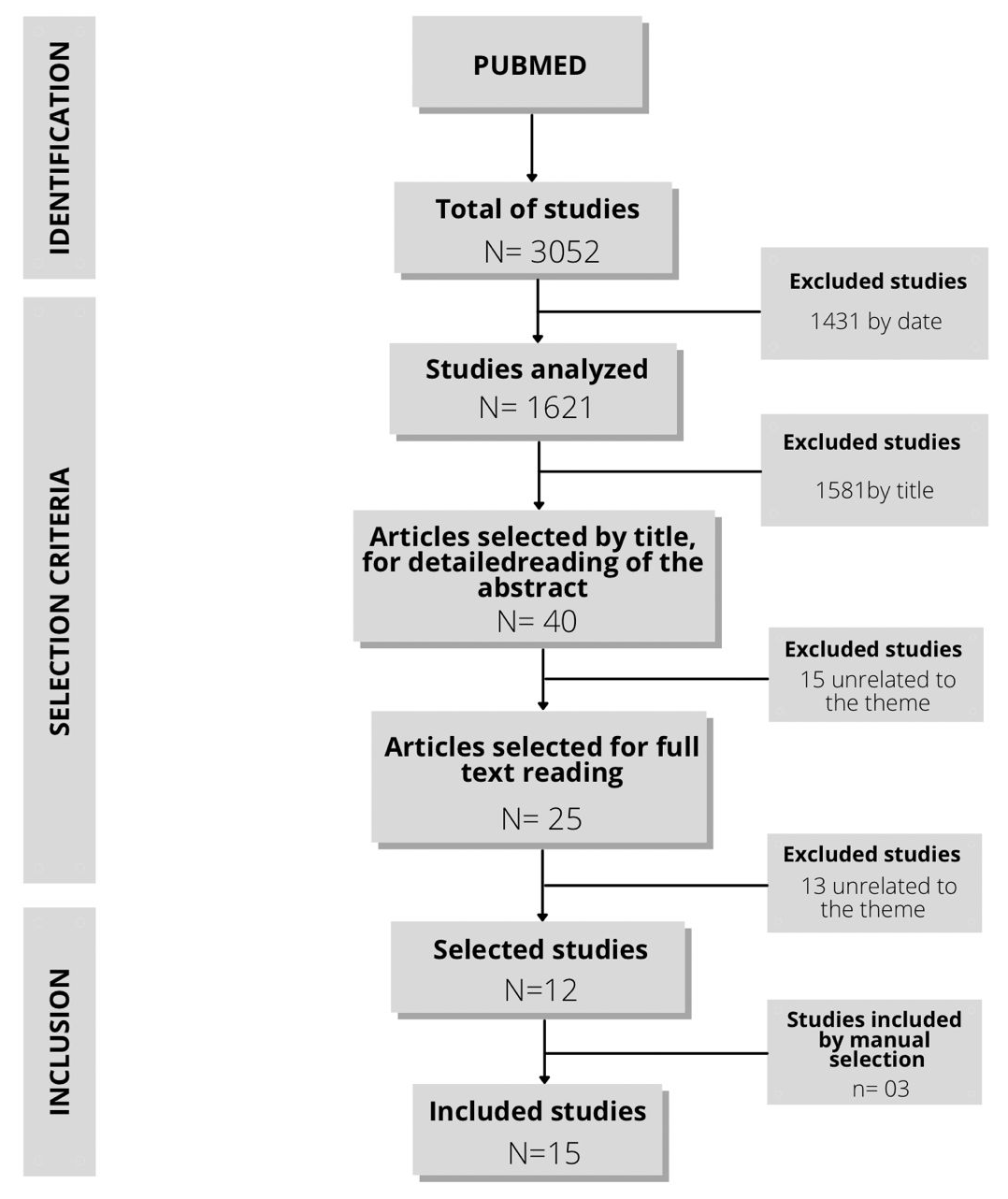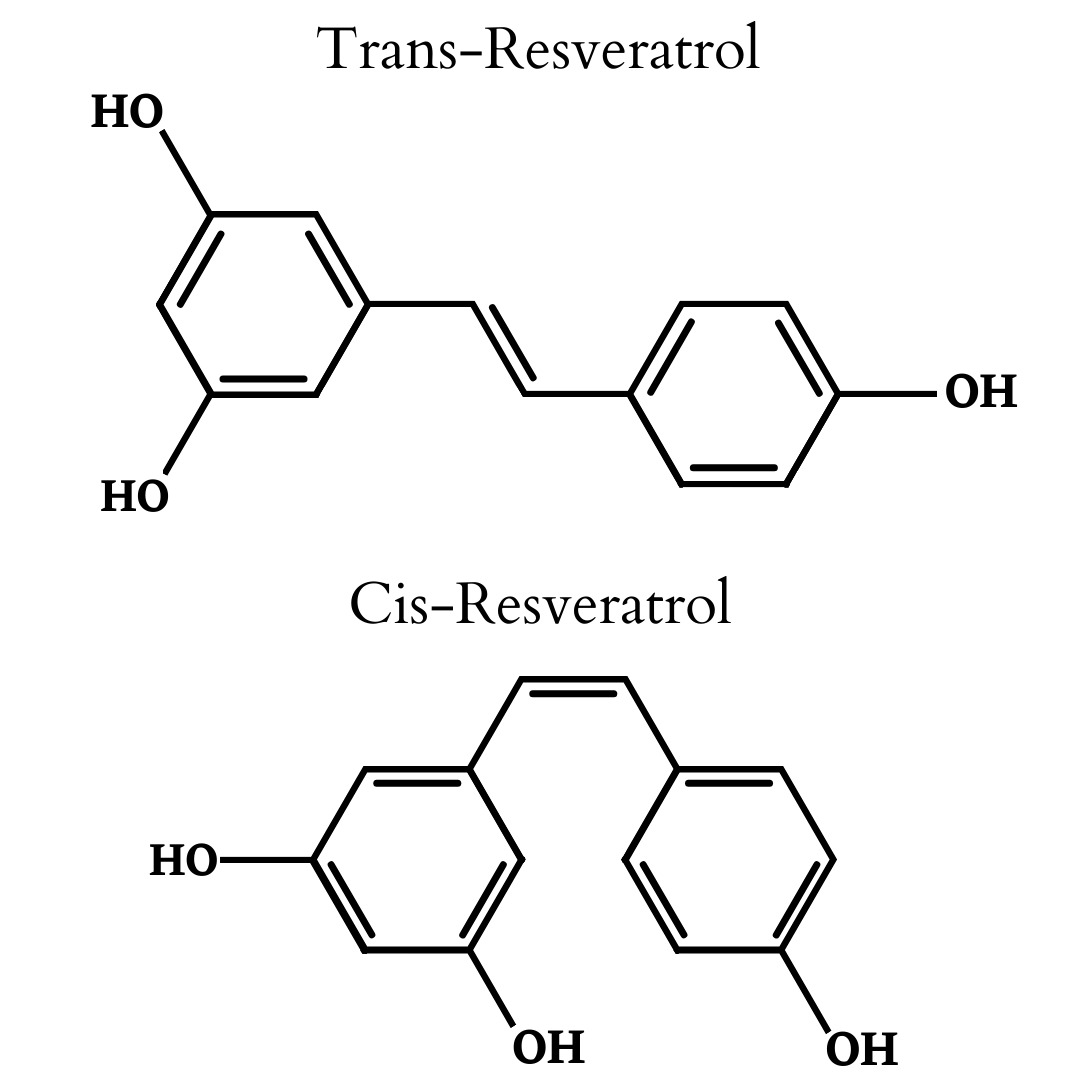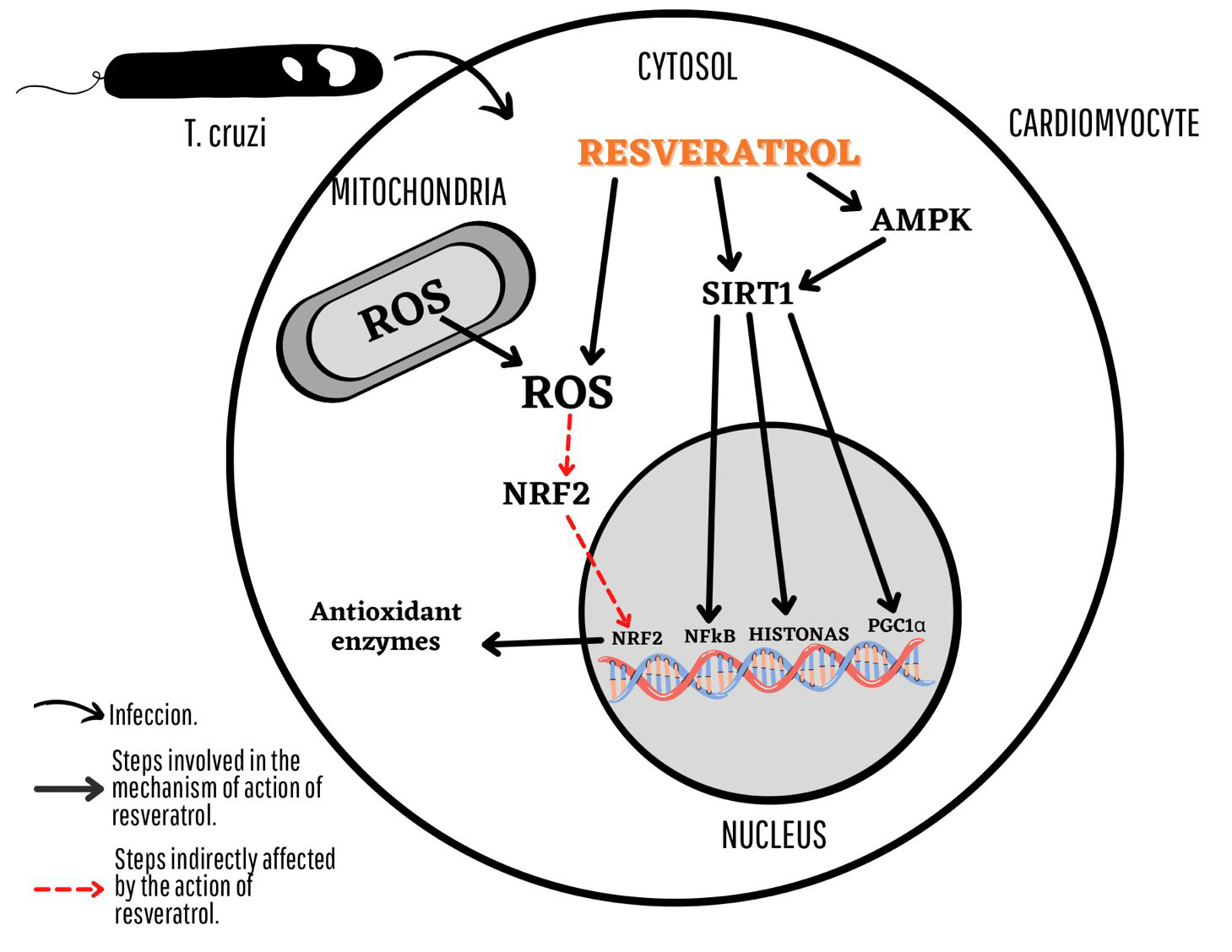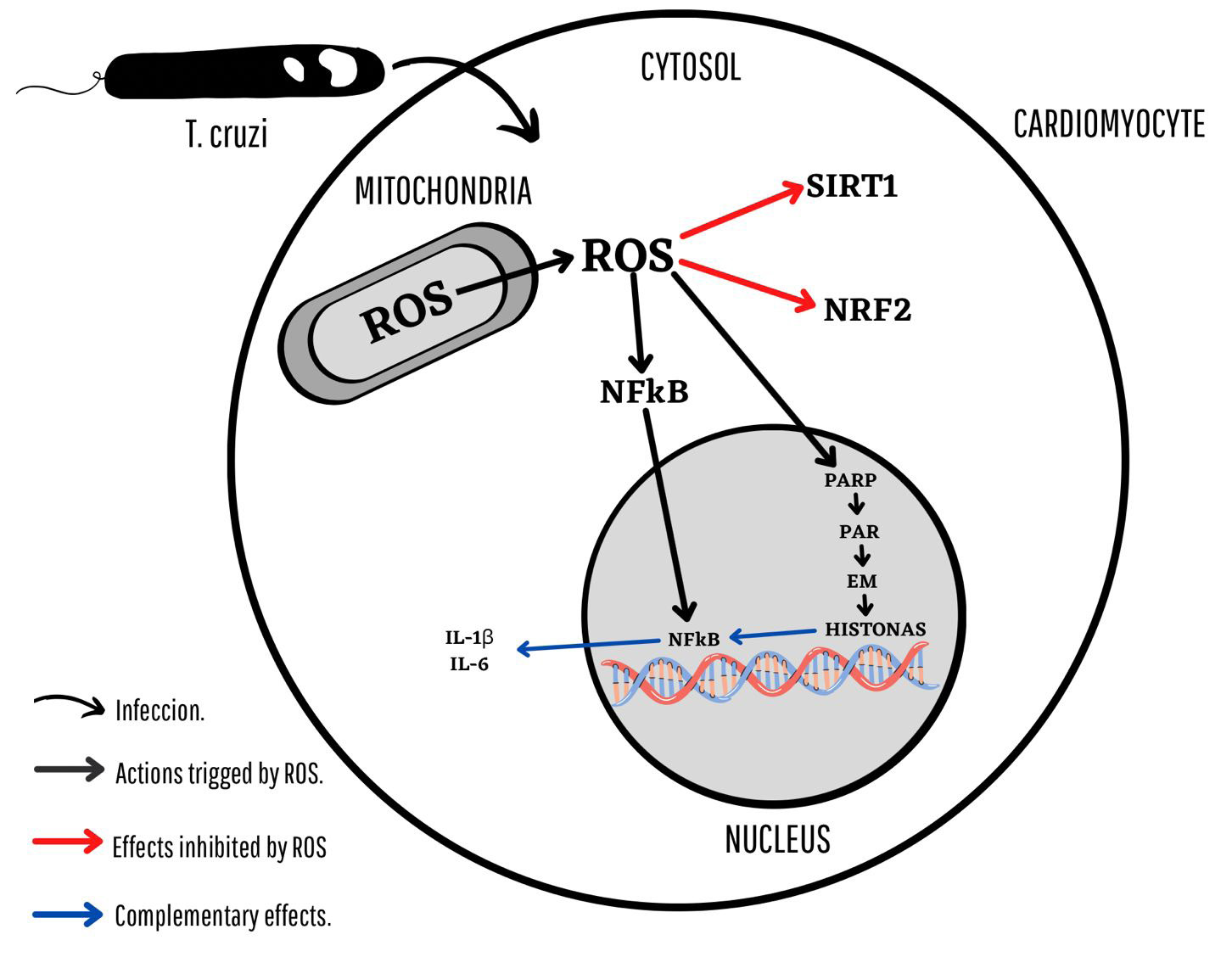Therapeutic Uses of Resveratrol Compound in Chagas Disease - A Literature Review
Introduction
Chagas disease, caused by the protozoan Trypanosoma cruzi, is an important public health problem that affects approximately 6 to 7 million people worldwide [1]. This neglected disease is endemic in South American countries and is caused by the unicellular and diploid protozoa of the Trypanosomatidae family. In Brazil, most cases are located in the North region of the country (94.67% of cases), followed by the Northeast (3.63% of cases) and Midwest regions of Brazil. The most common form of contagion is via the vector, however, oral transmission has also been increasing [2]. In humans, the infection goes through two distinct clinical stages, the onset of infection corresponds to the acute phase, which is characterized by high parasitemia and a large presence of parasites in the tissues, the later phase is the chronic phase, which is identified by low tissue parasitism and parasitemia, this phase persists throughout the host’s life [1]. About 30-40% of those infected with Chagas disease show signs of cardiac involvement and in the second stage of the disease between 60 and 70% of people do not develop chronic symptoms or associated diseases in the digestive tract (megacolon and megaesophagus) [3]. In this sense, drugs to control this late inflammation have been researched, since the drugs benznidazole and nifurtimox that are already in use, are aimed at the treatment of the acute infection phase [4].
Resveratrol is a compound that can be found in some plants, it demonstrates antioxidant action and regulates the immunity of humans. Some studies show that through the compound’s ability to reduce the amount of reactive oxygen molecules, resveratrol can be a good alternative to recover cardiac functions of patients affected by Chagas Disease [5]. There are also experimental studies highlighting the regulatory mechanisms and immunomodulatory role of resveratrol in vivo and in vitro. These data reveal the promising role of resveratrol in the prevention and therapy of a wide variety of chronic diseases and several infectious diseases, including Chagas disease [6]. The objective of this systematic review is to show how the compound resveratrol acts in different stages of the development of the parasite T. cruzi, and how it can be efficient in the combat of Chagas’ disease.
Methodology
This article is a literature review, which followed the recommendations of the Preferred Reporting Items for Systematic Reviews and Meta-Analyses. For its realization, the following database was consulted: PUBMED. On this basis, the following keywords were used: “Resveratrol”; “Chagas disease”; “Therapy”. After analyzing the studies found in the search, studies that met the following inclusion criteria were selected: publication date from January 2016 and directly linked to the topic. On the other hand, all articles published before the limiting date, which did not have a direct connection with the topic, discovered from the titles and reading of the abstracts, were excluded. We chose to keep the studies carried out on animals, as the topic is recent and there are no studies in human beings yet. In addition, some articles of extreme relevance for this article were manually selected. Of the total of 3052 articles found through the search strategy search, 1431 articles published prior to 2016 were excluded, 1581 articles were excluded from reading the title and 20 excluded from reading the abstract. After reading the abstracts, 25 articles were chosen for complete reading of the text, leaving 17 articles. Three articles were selected by manual search (Figure 1), leaving 15 articles as final references (Table 1).
Discussion
This review discusses the Resveratrol compound and its positive impact on the treatment of Chagas disease, as it protects cardiomyocytes from oxidative stress activated by the SIRT1 pathway. It is also worth emphasizing that reactive oxygen species (ROS) provide a favorable environment for the reproduction of T. cruzi and, paradoxically, it can also have a negative impact on the development of the protozoan in question [3]. Thus, it can be seen that Resveratrol shows very promising efficacy in experimental models and, due to this fact, the importance of this review is highlighted.
Resveratrol
Resveratrol is present in several plants, mainly in the skin of epidermal cells and the seeds of red grapes and their derivatives, but there is a low amount in the pulp. In animal and human pharmacokinetic studies, which are limited, resveratrol is absorbed in the gastrointestinal tract after ingestion [5] and undergoes rapid metabolism in the body [6] since the half-life of resveratrol is short and the effect is transient, so further clinical studies are needed to assess the effects of a high dose [7]. Its bioavailability after oral administration is very low, despite absorption reaching 70%. The compound Resveratrol - 3,5,4’-trihydroxystilbene - is a polyphenol from the stilbene family, having the cis and trans form (Figure 2), in addition to being a non-flavonoid [5]. A study showed that for the pathways for resveratrol-mediated cardioprotection to work positively there is the reduction of oxidative stress and the activation of endothelial nitric oxide synthase [5]. Furthermore, resveratrol regulates immunity by interfering with the regulation of immune cells, pro-inflammatory cytokines, and gene synthesis and expression. At the molecular level, this compound targets sirtuin, which is an enzyme that performs histone deacetylase [8].
Resveratrol and Sirtuin 1
Sirtuins are molecules that are part of histone deacetylases (HDAC) which belong to the class III family, and studies propose discussions on sirtuin 1 (SIRT-1) and its therapeutic effects. They have several metabolic actions such as the regulation of homeostasis, deacetylation of histone and non-histone proteins, neuroendocrine regulation and maintenance of reproductive hormones and oxidative stress [9]. This substance detects redox changes, so it is related to ROS [10]. It is known that resveratrol directly activates SIRT-1, as well as activating the AMPK pathway (protein kinase activated by adenosine monophosphate), which reinforces the activation and control of the life of SIRT-15. Through the SIRT-1 pathway, there is a decrease in the concentration of NFkB, and a consequent reduction in pro-inflammatory cytokines. Furthermore, it generates an increase in the concentration of PGC1alpha, which contributes to the expression of nuclear DNA and genes that control mitochondrial respiratory mechanisms. In addition, it is responsible for neutralizing the effects of ROS on NRF2, increasing the number of antioxidant enzymes [3] (Figure 3). Added to this is the fact that the administration of resveratrol in vivo together with cobalt protoporphyrin (CoPP) resulted in a reduction in parasitemia, which allowed us to interpret that genes activated by NRF2 interfere in the resistance to infection of the T. cruzi parasite [11]. The role of sirtuin against parasitic infections in mice is through the specific signaling of the SIRT1 variant - stimulated by its agonist SIRT1720. This sirtuin pathway has the ability to suppress oxidative stress and inflammation in the chronic phase of Chagas disease, especially in the heart [9]. This action occurs mainly when associated with sirtuin in the AMPK pathway, which is activated when exposed to stress, together they have cardioprotective capabilities in ROS-dependent cardiomyopathies.
It is also worth emphasizing the role of sirtuins, as SIRT1720 is characterized as a potent SIRT1 agonist, which aims to increase the deacetylation of target proteins in animal models and reduce oxidative stress in mice chronically infected with T. cruzi. Furthermore, it was studied how SIRT1720 manages to silence the pro-inflammatory polarization and the proliferation of monocytes and macrophages in mice infected with T. cruzi. It was concluded that SIRT1 activity decreased in Chagas disease, and treatment with SRT1720 (to increase SIRT1 activity) improved left ventricular function in Chagasic mice. This is important because studies have revealed that the clinical examination of the myocardial tissue is compromised with exaggerated inflammation, which ends up contributing to thrombosis, blockage of the right heart branch, left ventricular dilatation and chagasic heart failure in the chronic phase. In addition to these effects, it has been postulated that treatment with the resveratrol agonist decreases the generation of molecules associated with damage [8]. The study by Wan et al. showed that mice treated with SIRT1720 exhibited declines in stroke volume, cardiac output and ejection fraction, but these were not statistically significant, whereas those treated with resveratrol exhibited a moderate improvement in induced loss in end-systolic volume, in stroke volume and cardiac output and there was one that was statistically insignificant in ejection fraction [10].
In this review, the role of sirtuin that is of interest to us and that will be addressed is the fact that in its use it is the target of different pathological contexts and pharmacological and therapeutic targets. Of particular interest is its action against parasitic infections together with its specific activation of the SIRT1 type by the compound resveratrol [9]. According to Wan’s study, SIRT1 antagonists have partial beneficial effects in reducing cardiac factors in chagasic mice, in addition to controlling NFkappaB signaling of oxidative and inflammatory responses, which helps to preserve the ventricular function of mice. The use of resveratrol (a natural SIRT1 agonist) has been shown to increase the number of mitochondria and also the expression of genes for oxidative phosphorylation, leading to a partial recovery of cardiac output in infected mice and a better control of left ventricular mass, in addition to decreasing myocardial inflammation. The result was that SIRT1 antagonists were more effective in controlling adverse clinical outcomes of Chagas disease than agonists. However, SIRT1 agonists may represent a viable therapeutic approach to control chronic Chagas disease [8,10]. The signaling performed by SIRT1 through resveratrol has an antioxidant function in different preclinical models of chronic disease and is involved in the reduction of oxidative stress, neuroinflammation and prevention of arterial stiffness, among other results.
In this sense, it is clear that SIRT1 acts on the innate and adaptive immunity of the individual as well. This is interesting as myeloid-type innate immune cells provide an immune response of metabolic reprogramming and are targets of parasitic infections such as Trypanosoma cruzi, which can compromise the liver, spleen, and lymph nodes, and cause chronic brain and cardiac inflammation that can be fatal to the individual [9]. Treatment with this drug is reflected in the improvement of cardiac function [12]. In vitro mouse models have shown that if there is an activator of SIRT1, it can suppress the oxidative stress and inflammation characteristic of the chronic phase of Chagas disease. It was shown that there was no significant effect on splenic cells, despite decreasing infection in monocytes, macrophages and lymphocytes in chagasic mice [9], and finally, an increase in heart rate was observed, in addition to changes in the electrocardiogram of mice that were infected and analyzed after treatment with resveratrol [13]. The compound resveratrol had a strong antiparasitic effect, since there was decreased growth of the epimastigote, as its differentiation and replication was altered, promoting metacyclogenesis, and blocking the differentiation and/or replication of intracellular amastigotes. This reduced the amount of live parasites, while enabling protection against the immune response and the establishment of a chronic infection.
After these findings, this drug proved to be a strong candidate for a trypanocidal drug, as it not only affects the invasion of trypomastigotes, but also alters transcription levels, since the expression of surface proteins of trypomastigotes, which contain glycoprotein layers important for fixation in host cells, was reduced [14]. The antioxidant action of SIRT1 was prioritized through the compound resveratrol, which acts through the scavenging of peroxyl, superoxide and hydroxyl radicals [4], thus presenting a viable option for therapy of Chagas disease, even though its half-life is short and its effect transien [7]. Currently, however, although the SIRT1 pathway and its agonist resveratrol show promise, there is still a lack of resources and research to prove its effectiveness.
ROS (Reactive Oxygen Species)
ROS are very reactive and unstable molecules that can transform other molecules when they react with each other, they are produced by macrophages during parasitemia. These molecules are not enough to contain the parasite in the phagosome, but they manage to produce signals to stimulate the parasite’s growth and, if there is a low amount of ROS in the environment, trypomastigote metacyclogenesis occurs – confirming its questionable response to the oxidative environment [3]. The parasite’s antioxidant defenses are composed of several redox molecules found in organelles such as mitochondria, endoplasmic reticulum and cytosol, and mainly depend on trypanothione to detoxify hydrogen peroxide (H2O2) from the oxidative environment. This, in turn, protects T. cruzi against ROS produced by infected cells, being more expressive in more resistant strains of trypomastigotes treated with H2O2. T. cruzi shows effective resistance against several antioxidants that deal with ROS produced by infected host cells, which can cause damage to the infected tissue. In this discussion, the focus was on maintaining the oxidative stress of host cells and how T. cruzi reacts to antioxidants, specifically resveratrol [3].
Effects of ROS: T. cruzi being an obligate intracellular parasite, has developed ways to use the immune system’s oxidative metabolites to its advantage. This occurs through the detoxification systems - which make use of thiol and enzymes - of ROS and RNS (reactive nitrogen species), during the interactions of the parasite with host cells, thus ensuring the reproduction and survival of the parasite. In this sense, a thesis was established regarding the relationship between different ROS and how this oxidative stress interferes positively and negatively in Chagas’ disease. It is important to emphasize that the cardiomyopathy caused by parasitemia is dependent on oxidative stress, as this contributes to the long extension of the pathology. T. cruzi infects cardiomyocytes and thus, the host’s mitochondria begin to produce ROS that can activate poly ADP ribose polymerase (PARP), which will produce poly ADP ribose (PAR), which, in turn, produces epigenetic marks (EM) in the histones of the promoter genes and helps NFkB to bind to genes. These alterations lead to the activation of genes that will produce pro-inflammatory cytokines that will reduce the effects of SIRT1 and will prevent the translocation of NRF2 to the nucleus, which may also directly inactivate it. This will generate inhibition of the expression of genes that encode antioxidant enzymes [3] (Figure 4). Trypomastigotes have been shown to differentiate into amastigotes when exposed to high concentrations of hydrogen peroxide, increasing parasite replication.
However, there is evidence that ROS affect parasite growth (but only within macrophages that have not been stimulated) and that the production of cytokines, such as IFN-y (interferon-gama), is decreased. The study also shows that antioxidants increase the expression of the cytosolic protein ferritin H (H-Ft) and the iron channel ferroportin-1 (Fpn1), decreasing the labile iron present in macrophages, which leads to a reduction in the parasite load. It was observed that there are distinct effects of ROS on T. cruzi I or II strains, as the parasite load of cardiomyocytes infected with type II was reduced with the use of antioxidants, whereas with type I there was no such reduction [7]. Other studies analyzed different populations of T. cruzi (type I and type II), noting a predominance of type II in cardiac muscle cells, which respond to infection by activating several genes, producing cytokines and ROS. This finding is due to differential tissue tropism, in which the immune response and the parasite interfere with tissue tropism. Thus, it is possible that different strains respond differently to ROS. For example, oxidative stress, due to infection, increases the replication rate of T. cruzi II, whereas type I would be more susceptible to ROS, the increase in replication can be explained by a possible bioavailability of labile iron for the use of the parasite. In cultures infected with T. cruzi I, there was a greater production of ROS generated by mitochondrial dysfunction, that is, a faster and more intense response of cardiomyocytes.
Reactive oxygen species in type I strains of the parasites are efficient in controlling parasitemia, while for type II strains, ROS have no effect. Thus, ROS have a double effect on cells, as an increase can impair the intracellular growth of pathogens, but the opposite also occurs: increased oxidative stress can cause an increase in parasite replication [1]. On the other hand, some studies have shown that ROS collaborate with the growth of T. cruzi type II amastigotes inside macrophages, allowing for an increase in parasitism. This is due to the fact that when mice were treated with resveratrol there was a decrease in parasitemia [11].
ROS x Resveratrol: Studies show that the effects of the phenolic component, resveratrol, in a pre-clinical stage, culminate in the elimination of superoxide, hydroxyl and peroxyl radicals, as well as antioxidant properties through the elimination of radhydroxyl. Furthermore, there is a significant decrease in lipid peroxidation in the chagasic heart, something that mitigates the deleterious effects of Chagas disease on the body [4]. It is also worth noting that antioxidants act by preventing the replication of T.cruzi and that peroxynitrite (ONOO-) proved to be efficient in containing amastigotes inside the phagolysosome. Antioxidants used on the epimastigote form of the parasite were able to reduce proliferation and increase metacyclogenesis of T. cruzi. In contrast, oxidants and pro-oxidants had the opposite effect: an increase in cell growth of T. cruzi [13].
Neurological Approach
In addition to its cardiopathic role, T. cruzi demonstrates tropism in the Central Nervous System (CNS). The CNS is an extremely important site for the persistence of T. cruzi in the host during the chronic phase and this is made possible by the parasite’s ability to move through the blood-brain barrier, causing meningoencephalitis and cognitive and motor impairment, leading to death in the acute phase, as well as infecting astrocytes and Schwann cells. Studies used the compound resveratrol to see if it is able to avoid or minimize the negative effects of T. cruzi on the CNS, such as neuroinflammation, as it has an anti-inflammatory effect related to the modulation of intracellular signaling pathways. During CNS infection, T. cruzi influences the order of neurogenesis and gliogenesis, and consequently, neuroinflammation. In contrast, the compound resveratrol, with its neuroprotective effects, activates SIRT expression and directs neural migration to the correct order, that is, NPCs (neural precursor cells) are differentiated in the astroglial lineage at the expense of the neuronal lineage, increasing the number of neurospheres [15].
Final Considerations
Among the investigated studies, we observed that, currently, anti-chagasic therapies are not enough to fight the infection and damage caused by T. cruzi. In this sense, we saw the need for an approach involving humans in order to test SIRT1 and resveratrol, since there are data that justify a thorough investigation of these promising substances in order to obtain proof and use of their therapeutic effects on Chagas disease (Figure 5). There are several anti-parasitic drugs that are already used to treat this infection, the best known being benznidazole and nifurtimox. However, despite the positive effects, conventional therapy is toxic to the individual, and unfeasible for pregnant women, which further demonstrates the need for this study and for an alternative therapy to treat patients in the acute phase and reverse the consequences of the chronic phase [4]. In summary, from a future perspective, we see the need for clinical trials in humans, since SIRT1 - linked to its agonist resveratrol - are very promising substances not only in their relationship with oxidative stress, but also in improving cardiac function and decreased infiltration of monocytes and macrophages in cardiomyocytes of mice infected with T. cruzi.
Conclusion
This review makes some considerations regarding resveratrol. Oxidative stress and ROS interfere positively and negatively in T. cruzi parasitosis. Macrophages produce ROS in order to contain the parasite, but end up being insufficient in the containment of the parasite. In the presence of the SIRT1 activator, there is a suppression of oxidative stress in mice and of inflammation in the chronic phase of the infection, in addition to a reduction in infected cardiac cells, concomitantly with an improvement in left ventricular function. Resveratrol modulates many cellular and molecular mediators of the inflammatory response. However, some studies have reported that this compound can function as an antagonist, influencing chemokines and cytokines in opposite ways in different tissues. Strategies such as the use of resveratrol analogues are also being studied, as they reduce lipid peroxidation. Due to there only being therapeutics for the acute phase of the disease, more pre-clinical and clinical trials in humans are needed to clarify the mechanisms of action of resveratrol on various physiological conditions, in order to make this agent a leading therapeutic strategy for the prevention and treatment of Chagas disease.
For more Articles on: https://biomedres01.blogspot.com/







No comments:
Post a Comment
Note: Only a member of this blog may post a comment.